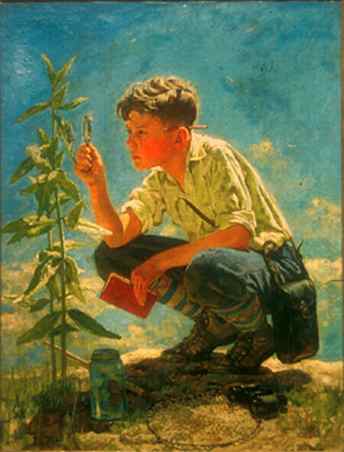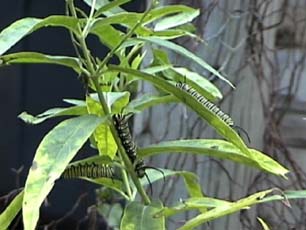|
Resources: Our certified Backyard Wildlife Habitat Garden
On this site Worksheet for this site Revised 8/2006 Comparing Caterpillars exercise Contrasting Caterpillars exercise Compare or Contrast Butterflies Milkweed True False Quiz updated Measuring Caterpillars and Milkweed leaves activity Milkweed Puzzle print Milkweed coloring page | Color this Butterfly Chart the classification of the Monarch Butterfly. MS/HS Chart the classification of the Common Milkweed . MS/HS Watering Milkweeds Spreadsheet project Observation Science skills practice Make a Compare/Contrast Diagram using a computer how to Make an Organisms Database - How to using AW Butterflies and Moths Facts Hunt Investigating Interesting Insect Information |
George Ericson, a.k.a. Eugene Iverd (1893-1936), Young Scientist, 1932, oil on canvas, Collection: Erie Art Museum, Erie, PA. Monarch Butterfly of Aster Way
The photos for this project were taken in August and early September in Central Pennsylvania. Aligned with PA Academic Standards Science and Technology Unifying Themes 3.1 4. C. Illustrate patterns that regularly occur and reoccur in nature. 7. C. Identify patterns as repeated processes or recurring elements in science and technology. Identify different forms of patterns and use them to group and classify specific objects. Inquiry and Design 3.2 B. Describe objects using the five senses. Apply process knowledge to make and interpret observations. Biological 3.3 - Sciences A. Know the similarities and differences of living things.
B. Know that living things are made up of parts that have specific functions. 3.7. Technological Devices B. Use appropriate instruments and apparatus to study materials.
Environment and Ecology Environmental Health 4.3 B. Identify how human actions affect environmental health. C. Understand that the elements of natural systems
are interdependent Integrated Pest Management 4.5 B. Explain how pest management affects the environment. Ecosystems and their interactions 4.6 A. Understand that living things are dependent on nonliving things in the environment for survival. Describe the basic needs of an organism. Mathematics Measurement and Estimation 2.3. A. Select and use appropriate instruments and units for measuring quantities (e.g., perimeter, volume, area, weight, time, temperature). Select and use standard tools to measure the size of figures with specified accuracy, including length, width, perimeter and area. Mathematical Reasoning and Connections 2.4. A. Compare quantities and magnitudes of numbers. Reading Writing Listening Reading Critically in all content areas 1.2 A. Read and understand essential content of informational texts Types of Writing 1.4 B. Write informational pieces Speaking and Listening 1.6 F. Use media for learning purposes. Pennsylvania Science Anchors
Borror, Donald J. and White, Richard E. Insects Peterson Field Guides. Houghton Mifflin Company. Boston. 1970. Foster, Stephen and Duke, James A. Medicinal Plants Peterson Field Guides . Houghton Mifflin Company. Boston. 1990. Hutchens, Alma R. Indian Herbalogy of North America. Shambhala Publications, Inc. Boston. 1973. McGavin, George C. The Pocket Guide to Insects of the Northern Hemisphere. Parkgate Books Ltd. London 1998 Tufts, Craig. The Backyard Naturalist. National Wildlife Federation. 1988.
|
![]()
All trademarks, copyright and logos belong to
their respective owners.
©2003 Cynthia O'Hora All rights reserved. Updated June 2024



 Cited Works:
Cited Works: